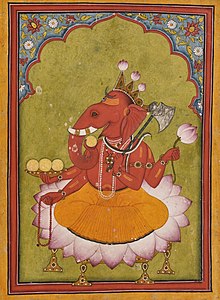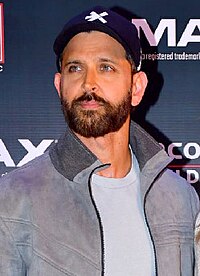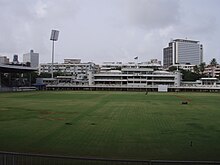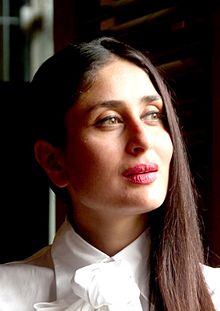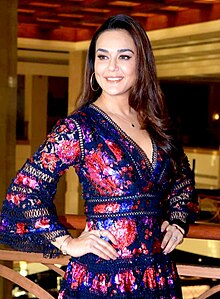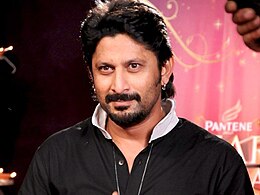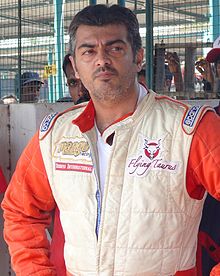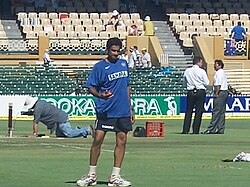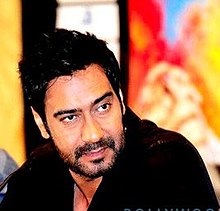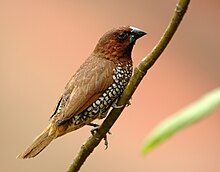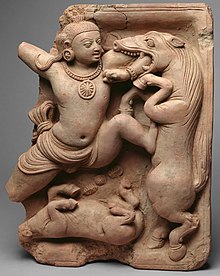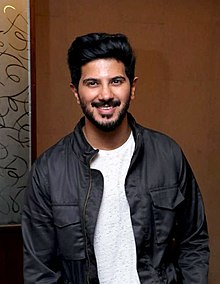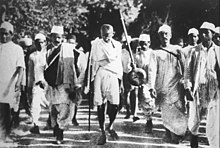Portal:India
Introduction

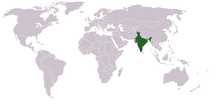
India, officially the Republic of India (ISO: Bhārat Gaṇarājya), is a country in South Asia. It is the seventh-largest country by area; the most populous country since April 2023; and from the time of its independence in 1947, the world's most populous democracy. Bounded by the Indian Ocean on the south, the Arabian Sea on the southwest, and the Bay of Bengal on the southeast, it shares land borders with Pakistan to the west; China, Nepal, and Bhutan to the north; and Bangladesh and Myanmar to the east. In the Indian Ocean, India is in the vicinity of Sri Lanka and the Maldives; its Andaman and Nicobar Islands share a maritime border with Thailand, Myanmar, and Indonesia. (Full article...)
Selected pictures
The company has also produced regional languages films like 72 Miles (Marathi) and Bhaji in Problem (Punjabi). Both of these opened to positive reviews from critics. The former one was screened at the London and Pune International Film Festivals and won 3 awards at the 2014 Maharashtra State Film Awards ceremony. The company has also produced the Hindi soap opera Jamai Raja which airs on Zee TV. Kumar had appearances in all of his films except 72 Miles. (Full article...)
Dulquer Salmaan (IPA: [d̪ulkʰɐr salmaːn]; born 28 July 1983/1986) is an Indian actor, playback singer and film producer who predominantly works in Malayalam, Tamil, Telugu and Hindi films. He graduated with a bachelor's degree in business management from Purdue University and worked as a business manager in Dubai before pursuing a career in acting. Dulquer is a recipient of several awards including, five Filmfare Awards South and a Kerala State Film Award.
After a three-month acting course at the Barry John Acting Studio, Salmaan made his acting debut with Second Show (2012). He has since established himself as a leading actor in Indian cinema with several critically and commercially successful films including Ustad Hotel (2012), ABCD (2013), Neelakasham Pachakadal Chuvanna Bhoomi (2013), Vaayai Moodi Pesavum (2014), Bangalore Days (2014), Vikramadithyan (2014), O Kadhal Kanmani (2015), Charlie (2015), Kali (2016), Kammatti Paadam (2016), Jomonte Suvisheshangal (2017), Mahanati (2018), Kurup (2021) and Sita Ramam (2022). (Full article...)
All persons born in India between 26 January 1950 and 1 July 1987 automatically received citizenship by birth regardless of the nationalities of their parents. Between 1 July 1987 and 3 December 2004, citizenship by birth was granted if at least one parent was a citizen. Individuals born in the country since then receive Indian citizenship at birth only if both parents are Indian citizens, or if one parent is a citizen and the other is not considered an illegal migrant. (Full article...)
Dil Chahta Hai was based on Akhtar's diary detailing his trips to Mumbai and New York City, and a story by a friend of his, Kassim Jagmagia, who would ultimately become a creative associate at Excel Entertainment. He started writing the screenplay in 1998 but finished it when the film's principal photography was started two years later. The film was produced on a budget of ₹80 million (US$960,000), and filming took place in both India and Australia. It was one of the first films shot in sync sound, with Nakul Kamte and H. Sridhar handling its sound recording. The trio Shankar–Ehsaan–Loy, with lyrics penned by Akhtar's father, Javed Akhtar, composed the soundtrack and the background score. (Full article...)
Founded in 2014 as a Facebook page, Manjappada later expanded and have branches in each of Kerala's 14 districts and in 12 other Indian states; Keralites in 64 other countries are also part of the group. Manjappada is also known for having one of the largest groups of travelling fans in the country, and their presence in the stadium is often called a yellow sea as they wear as much yellow as possible during the matches of the Blasters. In the 2022–23 Indian Super League season, they displayed a 11752 sq ft tifo, which is so far the largest tifo displayed during a football match in Asia. (Full article...)
Puri (Odia: [ˈpuɾi] ) is a coastal city and a municipality in the state of Odisha in eastern India. It is the district headquarters of Puri district and is situated on the Bay of Bengal, 60 kilometres (37 mi) south of the state capital of Bhubaneswar. It is home to the 12th-century Jagannath Temple and is one of the original Char Dham pilgrimage sites for Hindus.
Puri known by several names since ancient times, and was locally known as "Sri Kshetra" and the Jagannath temple is known as "Badadeula". Puri and the Jagannath Temple were invaded 18 times by Muslim rulers, from the 7th century AD until the early 19th century with the objective of looting the treasures of the temple. Odisha, including Puri and its temple, were part of British India from 1803 until India attained independence in August 1947. Even though princely states do not exist in India today, the heirs of the House of Gajapati still perform the ritual duties of the temple. The temple town has many Hindu religious mathas or monasteries. (Full article...)
The Salt march, also known as the Salt Satyagraha, Dandi March, and the Dandi Satyagraha, was an act of nonviolent civil disobedience in colonial India, led by Mahatma Gandhi. The 24-day march lasted from 12 March 1930 to 6 April 1930 as a direct action campaign of tax resistance and nonviolent protest against the British salt monopoly. Another reason for this march was that the Civil Disobedience Movement needed a strong inauguration that would inspire more people to follow Gandhi's example. Gandhi started this march with 78 of his trusted volunteers. The march spanned 387 kilometres (240 mi), from Sabarmati Ashram to Dandi, which was called Navsari at that time (now in the state of Gujarat). Growing numbers of Indians joined them along the way. When Gandhi broke the British Raj salt laws at 8:30 am on 6 April 1930, it sparked large-scale acts of civil disobedience against the salt laws by millions of Indians.
After making the salt by evaporation at Dandi, Gandhi continued southward along the coast, making salt and addressing meetings on the way. The Congress Party planned to stage a satyagraha at the Dharasana Salt Works, 40 km (25 mi) south of Dandi. However, Gandhi was arrested on the midnight of 4–5 May 1930, just days before the planned action at Dharasana. The Dandi March and the ensuing Dharasana Satyagraha drew worldwide attention to the Indian independence movement through extensive newspaper and newsreel coverage. The satyagraha against the salt tax continued for almost a year, ending with Gandhi's release from jail and negotiations with Viceroy Lord Irwin at the Second Round Table Conference. Although over 60,000 Indians were jailed as a result of the Salt Satyagraha, the British did not make immediate major concessions. (Full article...)
In December 1961, Salaria was among the Indian troops deployed to the Republic of the Congo as part of the United Nations Operation in the Congo. On 5 December, as part of Operation Unokat, Salaria's battalion was tasked to clear a roadblock of two armoured cars manned by 150 gendarmes of the secessionist State of Katanga on the way to the Elizabethville Airport. The plan was that Salaria and his men were to block their retreat. His rocket launcher team attacked and destroyed the Katangese armoured cars. This unforeseen move confused the Katangese gendarmes, and Salaria felt it would be best to attack before they reorganised. Though his troops were outnumbered, they charged towards the Katangese and killed 40 men in a kukri assault. During the attack, Salaria was shot twice in the neck and eventually succumbed to his injuries. The remaining gendarmes fled in confusion, leaving their dead and wounded behind. This helped the main battalion to easily overrun the Katangese and clear the roadblock. For his duty and courage, and disregard for his own safety during the battle, Salaria was awarded the PVC. (Full article...)
The "Kolkata class" (Project 15A) are a class of stealth guided-missile destroyers constructed for the Indian Navy. The class comprises three ships – Kolkata, Kochi and Chennai, all of which were built by Mazagon Dock Limited (MDL) in India, and are the largest destroyers to be operated by the Indian Navy. Due to delays in construction and sea trials, the initial commissioning date of the first ship of the class was pushed back from 2010 to 2014.
The destroyers are a follow-on of the Project 15 Delhi-class destroyers, but are considerably more capable due to major improvements in the design, the addition of substantial land-attack capabilities, the fitting-out of modern sensors and weapons systems, and the expanded use of net-centric capability such as Cooperative Engagement Capability. (Full article...)
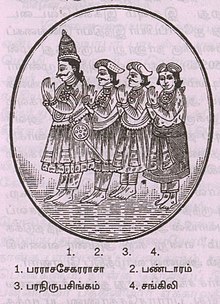
The Arya Chakravarti dynasty (Tamil: ஆரியச் சக்கரவர்த்திகள் வம்சம், Sinhalese: ආර්ය චක්රවර්තී රාජවංශය) were kings of the Jaffna Kingdom in Sri Lanka. The earliest Sri Lankan sources, between 1277 and 1283, mention a military leader of this name as a minister in the services of the Pandyan Empire; he raided the western Sri Lankan coast and took the politically significant relic of the Buddha's tooth from the Sinhalese capital city of Yapahuwa. Political and military leaders of the same family name left a number of inscriptions in the modern-day Tamil Nadu state, with dates ranging from 1272 to 1305, during the late Pandyan Empire. According to contemporary native literature, such as Cekaracecekaramalai, the family also claimed lineage from the Tamil Brahmins of the prominent Hindu pilgrimage temple of Rameswaram in the modern Ramanathapuram District of India. They ruled the Jaffna kingdom from the 13th until the 17th century, when the last of the dynasty, Cankili II, was ousted by the Portuguese. (Full article...)

Field Marshal Kodandera Madappa Cariappa, OBE (28 January 1899 – 15 May 1993) was an Indian military officer and diplomat who was the Indian Commander-in-Chief (C-in-C) of the Indian Army. He led Indian forces on the Western Front during the Indo-Pakistani War of 1947. He was appointed Commander-in-Chief of the Indian Army in 1949. He is one of only two Indian Army officers to hold the five-star rank of Field Marshal; the other being Field Marshal Sam Manekshaw.
His distinguished military career spanned almost three decades. Born in Madikeri, Kodagu, Cariappa joined the British Indian Army shortly after the end of World War I, and was commissioned as a temporary first lieutenant into the 2/88 Carnatic Infantry. He was transferred between multiple regiments early in his career before settling on 1/7 Rajputs, which became his permanent regiment. (Full article...)
Set in the late 18th century during the early stages of the British Raj, the film tells the story of twin brothers separated at birth. Pulikesi XXIII, the foolish elder brother, becomes a puppet of his uncle, the Chief Minister, while Ukraputhan, the wise younger brother, becomes a patriot intent on saving his land and his brother. (Full article...)
News
- 26 July 2024 – China–India relations, Sino-Indian border dispute
- China and India agree to cooperate in withdrawing all their troops from their disputed border, with aims of peacefully achieving "complete disengagement" from the border conflict as quickly as possible. (AP)
- 19 July 2024 –
- WazirX, an Indian cryptocurrency exchange owned by Binance, announces a security breach in which $234 million USD in cryptocurrency was stolen, amounting to half of the platform's total assets. (Business Standard)
- 18 July 2024 – Naxalite–Maoist insurgency
- Two Indian soldiers are killed and four others are injured in an IED attack by Maoists in Chhattisgarh, India. (The Hindustan Times) (India Blooms)
- 17 July 2024 –
- Comoros-flagged oil tanker Prestige Falcon capsizes off the coast of Oman. The Indian Navy rescues nine crew members, with seven others missing. (AP)
- 13 July 2024 –
- The Guardia di Finanza frees 33 Indian farm workers from exploitative conditions in Verona, Veneto, Italy, and seizes nearly €500,000 (US$545,000) from two Indian individuals accused of charging workers €17,000 ($18,500) each for permits. (AP)
Did you know...
- ... that Samuel Green printed the Eliot Indian Bible, the first Bible printed in British America, in 1663?
- ... that the Indian politician Diwan Chaman Lall failed to get rid of the painting Nude of Indira?
- ... that Indian historian R. Champakalakshmi was a script consultant for Bharat Ek Khoj, a television series based on Jawaharlal Nehru's The Discovery of India?
- ... that Mao Zedong initially approved the Dalai Lama's escape into Indian exile, but later ordered that it be prevented?
- ... that Abdul Ghani Azhari wrote Qadim Tarikh-e-Gujjar in Urdu, detailing the ancient history of Gujjars in India?
- ... that Wankaner's Ranjit Vilas Palace in Gujarat, India, features Venetian Gothic, Italianate, Mughal and Rajput styles?
Topics related to India
Timeline of Indian history, Indus Valley Civilisation, Dholavira, Science and technology in ancient India, Meluhha, Aryan invasion theory, Out of India theory, Greek conquests in India, Indian maritime history, Maurya Empire, Ashoka, Shunga Empire, Hoysala Empire, Vijayanagara, Satavahana dynasty, Indo-Greek Kingdom, Indo-Scythians, Indo-Parthian Kingdom, Kushan Empire, Western Satraps, Gupta Empire, Chola dynasty, Pala Empire, Islamic incursions in India, Mughal Empire, Maratha Empire, British Raj, East India Company, Governor-General, Viceroy, War of Independence, 1857, Indian independence movement, Indian National Army, Azad Hind, Quit India Movement, Partition of India, History of Republic of India, Non-Aligned Movement, Sino-Indian War, Indo-Pakistani War of 1947–1948, Indo-Pakistani War of 1965, Indo-Pakistani War of 1971, Kargil War, 2001–02 India–Pakistan standoff, Military, Demographic
Law, Hindu law, Constitution, Political parties (Indian National Congress, Bharatiya Janata Party), Foreign relations, Elections, Political divisions, Reservation in India
Government agencies, Legislative branch (Lok Sabha, Rajya Sabha) Executive branch (President & Vice President, Prime Minister & Deputy Prime Minister, Cabinet Ministers, Cabinet Secretary, Election Commission, Foreign Minister; Law enforcement: CBI, CID, Intelligence: IB, RAW), Directorate General of Income Tax Investigation Judicial branch (Supreme Court), Armed Forces (Army, Navy, Air Force, Border Security Force, Coast Guard)
Himalayas, Western Ghats, Eastern Ghats, Indo-Gangetic Plain, Deccan Plateau, Thar Desert, Ganges, Rann of Kutch, Brahmaputra River, Northeast India; Mountains, Valleys, Islands, Rivers; States and union territories, Cities, Districts, Regions, Fauna, Flora
Rupee, Bombay Stock Exchange, National Stock Exchange, Standard of living, Companies, Reserve Bank of India, Energy policy (Solar, Wind, Nuclear), Tourism, Transport (Expressways, Rail transport, Auto rickshaw),
Languages, Standard of living, Religion
Music (Carnatic, Hindustani, Indi-pop), Dance, Languages, Literature, Architecture, Film & TV, Cuisine, Holidays, Folklore, Education, Media, Indian martial arts
Indian Council of Agricultural Research (ICAR), Indian Institute of Astrophysics, National Centre for Software Technology, AIIMS, IISc, IIT, NIT, BITS-Pilani, INRegistry, Indian numbering system, Indian Space Research Organisation, National Internet Exchange of India, ICRISAT, International Institute of Information Technology, Hyderabad
Indian English, Indian nationality law, Numbering system, Indian Space Research Organisation, Telecommunications, National Highways Development Project, Flag, Vehicle registration plates, Indian nationalism, Metrication in India
Categories
Related portals
Religions in India
Indian Subcontinent
Other countries
Wikipedias in Indian languages
- অসমীয়া (Assamese)
- বাংলা (Bengali)
- भोजपुरी (Bhojpuri)
- বিষ্ণুপ্রিয়া মণিপুরী (Bishnupriya Manipuri)
- गोंयची कोंकणी / Gõychi Konknni (Konkani)
- ગુજરાતી (Gujarati)
- हिन्दी (Hindi)
- ಕನ್ನಡ (Kannada)
- कॉशुर/كشميري (Kashmiri)
- मैथिली (Maithili)
- മലയാളം (Malayalam)
- मराठी (Marathi)
- नेपाली (Nepali)
- नेपाल भाषा
- (Newari)
- ଓଡ଼ିଆ (Odiya)
- ਪੰਜਾਬੀ (Punjabi)
- पालि (Pali)
- संस्कृत (Sanskrit)
- ᱥᱟᱱᱛᱟᱲᱤ (Santali)
- سنڌي (Sindhi)
- தமிழ் (Tamil)
- తెలుగు (Telugu)
- ತುಳು (Tulu)
- اردو (Urdu)
Associated Wikimedia
The following Wikimedia Foundation sister projects provide more on this subject:
-
Commons
Free media repository -
Wikibooks
Free textbooks and manuals -
Wikidata
Free knowledge base -
Wikinews
Free-content news -
Wikiquote
Collection of quotations -
Wikisource
Free-content library -
Wikiversity
Free learning tools -
Wikivoyage
Free travel guide -
Wiktionary
Dictionary and thesaurus











